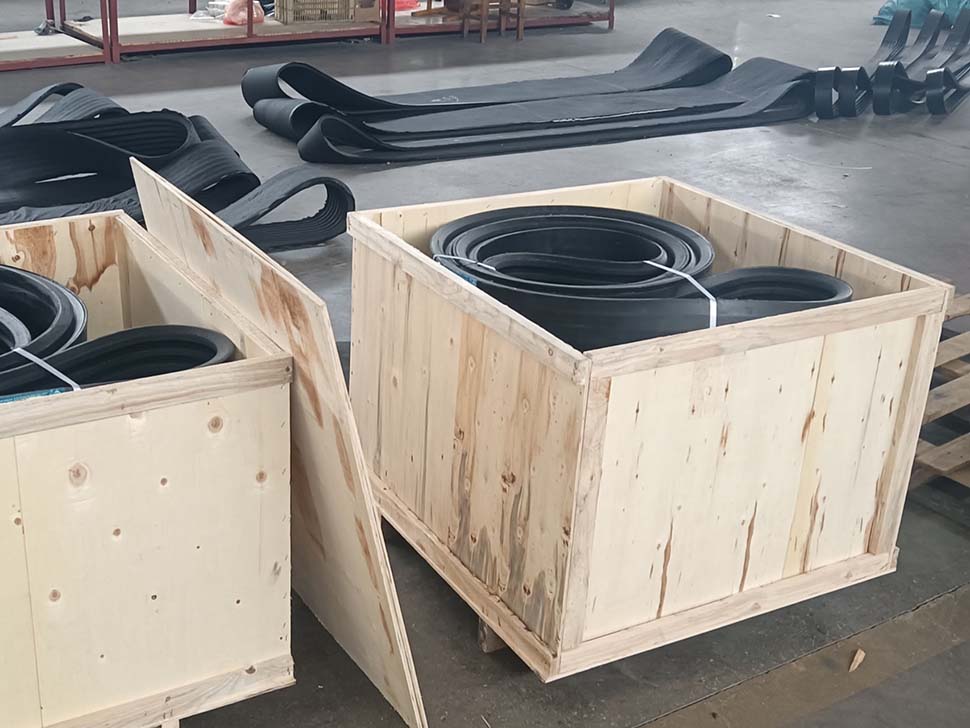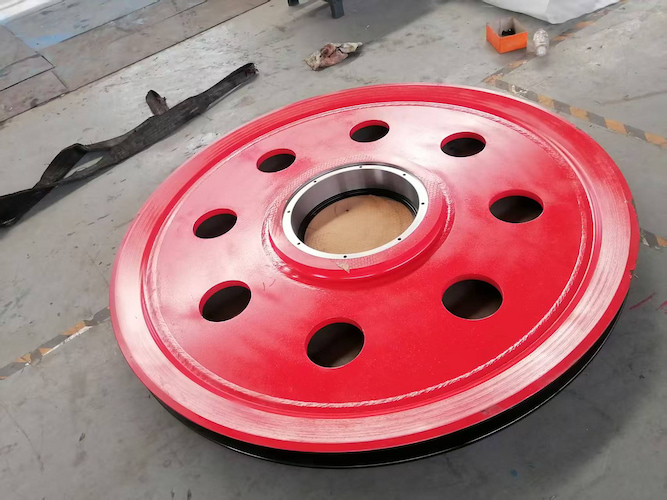What is the transmission system of an oil drilling rig?
Apr 18, 2025
The transmission system of an oil drilling rig is a device that transfers the energy from the power source to various working machines, enabling the hoisting, rotation, circulation and other systems of the drilling rig to work in coordination. The following is a detailed introduction to its composition and characteristics:
Ⅰ. Components
Gearbox: It is used to reduce the rotational speed and increase the torque to meet the rotational speed and torque requirements of different working machines. For example, the drawworks requires a large torque to hoist and lower the drilling tools. Through the gearbox, the high rotational speed and low torque of the power source can be converted into the low rotational speed and high torque required by the drawworks.
Clutch: It is a component in the transmission system used to connect and cut off the power transmission. It allows the working machine to engage with the power source when needed to obtain power for operation, and can also cut off the power when not needed to achieve the independent operation or stop of the working machine. Common types include jaw clutches and friction clutches.
Coupling: It is used to connect the shafts of different components, transmit torque and rotational motion, and at the same time compensate for the installation errors and relative displacements between the shafts. For example, when connecting the shafts of the power source and the gearbox, and the gearbox and the working machine, the coupling can ensure the effective transmission of power and adapt to the slight deformation and displacement of the shafts during the operation of the equipment.
Drive shaft: It is an important component for power transmission, usually made of high-strength steel, and is used to transmit torque and rotational motion between different components. The drive shaft needs to have sufficient strength and stiffness to withstand the huge torque and bending moment during the transmission process.
Chain and sprocket for workover rig: In the transmission system of some oil drilling rigs, chains and sprockets are used to transmit power. The chain is put on the sprocket, and the rotation of the sprocket drives the chain to move, thus transmitting power from one component to another. Chain drive has the advantages of high transmission efficiency and can adapt to a relatively large center distance.
Belt drive device: Generally composed of banded V belts and pulleys, it transmits power through the frictional force between the belt and the pulleys. Belt drive has the characteristics of smooth transmission, buffering and vibration absorption, and overload protection. It is often used in parts where the requirements for transmission accuracy are not high and a certain degree of flexible transmission is needed.
Ⅱ. Transmission ModesIn actual oil drilling rigs, a composite transmission system that combines multiple transmission modes is usually adopted according to factors such as the type of the drilling rig, working conditions, and performance requirements, so as to give full play to the advantages of various transmission modes and meet the complex requirements of oil drilling operations.
Mechanical Transmission System
Composition and Functions of Components
Gear transmission: Composed of meshing gears, it transmits power and motion through the meshing of the teeth of the gears. It can achieve a large transmission ratio, has high transmission efficiency, a compact structure, and reliable operation. It is often used in components such as gearboxes and transfer cases to meet the rotational speed and torque requirements of different working machines.
Chain transmission: Composed of a chain and sprockets, the chain is put on the sprockets, and the rotation of the sprockets drives the chain to move, thereby transmitting power to other components. It is suitable for the transmission between two shafts with a relatively large center distance, can adapt to harsh working environments, and has a relatively high transmission efficiency. For example, the winch drive part of the drilling rig may use chain transmission.
Belt drive: Generally composed of a belt and pulleys, it relies on the frictional force between the belt and the pulleys to transmit power. It has the advantages of smooth transmission, buffering and vibration absorption, and the belt will slip on the pulley to play a protective role when overloaded. It is often used in the transmission of auxiliary equipment of the drilling rig where the requirements for transmission accuracy are not high and a certain degree of flexible transmission is needed.
Characteristics: The mechanical transmission system has high transmission efficiency, reliable operation, can transmit large torque and power, has a relatively simple structure, and low maintenance cost. However, the transmission ratio is fixed, the flexibility is poor, there are many components, and the requirements for installation and debugging are relatively high.
Hydraulic Transmission System
Composition and Functions of Components
Torque converter: It is the core component of the hydraulic transmission system, mainly composed of a centrifugal pump impeller, a turbine, and a guide wheel. The pump impeller is connected to the power source and converts mechanical energy into the kinetic energy of the liquid; the turbine is connected to the working machine and converts the kinetic energy of the liquid into mechanical energy for output; the guide wheel plays the role of changing the flow direction of the liquid and increasing the torque. The torque converter can automatically change the output torque and rotational speed under different working conditions, enabling the drilling rig to have good adaptability.
Hydraulic pump: It converts mechanical energy into hydraulic energy, provides high-pressure oil for the hydraulic transmission system, and drives the execution components such as the torque converter and the hydraulic motor to work.
Hydraulic motor: It converts hydraulic energy into mechanical energy and is used to drive the working machines of the drilling rig, such as the drawworks and the oil drilling rotary table. The hydraulic motor has good speed regulation performance and a large torque output capacity.
Characteristics: The hydraulic transmission system has good overload protection performance. When the working machine encounters an overload, the torque converter will automatically slip to protect the equipment from damage. At the same time, it has stepless speed regulation performance, can smoothly adjust the rotational speed and torque according to the work requirements, and has strong buffering and vibration absorption capabilities, which can make the start and operation of the drilling rig more stable. However, the transmission efficiency of the hydraulic transmission system is relatively low, especially at low loads, and the system structure is complex, with high maintenance costs.
Electric Transmission System
Composition and Functions of Components
Generator: It converts mechanical energy into electrical energy and provides a power source for the electric transmission system. It is usually driven by a diesel engine or other power sources to generate three-phase alternating current.
Electric motor: It converts electrical energy into mechanical energy and drives each working machine of the drilling rig. According to different working requirements, different types and powers of electric motors can be selected. For example, DC motors have good speed regulation performance, and AC variable frequency motors have the advantages of high efficiency, energy conservation, and a wide speed regulation range.
Frequency converter: It is used to adjust the power frequency of the AC motor, thereby achieving stepless speed regulation of the motor. By changing the output frequency of the frequency converter, the rotational speed of the motor can be precisely controlled to meet the requirements of different working conditions during the drilling process.
Control system: It includes various electrical components, controllers, and sensors, etc., and is used to monitor, control, and protect the electric transmission system. It can realize operations such as starting, stopping, speed regulation, and forward and reverse rotation of the motor, and at the same time monitor parameters such as the voltage, current, and temperature of the system. When an abnormal situation occurs, it will take timely protective measures to ensure the safe operation of the system.
Characteristics: The electric transmission system has high transmission efficiency, good speed regulation performance, can achieve precise speed control and torque control, is easy to realize automation and intelligent control, and can improve the efficiency and quality of drilling operations. In addition, the electric transmission system operates stably, has low noise, and causes little pollution to the environment. However, the electric transmission system requires a reliable power supply, has high requirements for the stability of the power grid, and the equipment investment cost is relatively large.
Composite Transmission System
Composition and Forms: The composite transmission system is a transmission system that combines multiple transmission modes such as mechanical transmission, hydraulic transmission, and electric transmission. Common composite transmission forms include mechanical-hydraulic composite transmission, mechanical-electric composite transmission, and hydraulic-electric composite transmission, etc. For example, in some large oil drilling rigs, the mechanical-hydraulic composite transmission mode of diesel engine-torque converter-gearbox may be adopted to drive the winch, taking advantage of the good adaptability of the torque converter and the high efficiency of gear transmission to meet the working requirements of the winch; at the same time, the electric transmission mode is adopted to drive the rotary table to achieve precise speed regulation and control of the rotary table.
Characteristics: The composite transmission system can give full play to the advantages of various transmission modes, select appropriate transmission modes according to the characteristics and working condition requirements of different working machines of the drilling rig, thereby improving the overall performance and adaptability of the drilling rig. It can ensure the reliability and transmission efficiency of the drilling rig while achieving better speed regulation performance and automation control level. However, the system structure is complex, and the design, installation, and maintenance are more difficult.
Read More





 Language :
Language : English
English Русский
Русский عربي
عربي
 GET A QUOTE
GET A QUOTE




 IPv6 network supported
IPv6 network supported